Heo recently made public a new collection of 33 statues depicting bicheon, virtuous, celestial maidens, or devas from the Buddhist world, showing them in public for the first time in over ten years. The exhibition is titled “Pine Trees Become Bicheon.”
Back in 2002, he held his first exhibition where he showed 33 statues of the bodhisattva Avalokitesvara carved out of ginkgo wood. This time, he has chiseled the 33 deva statues out of pine wood, using trunks more than 80 centimeters in diameter.
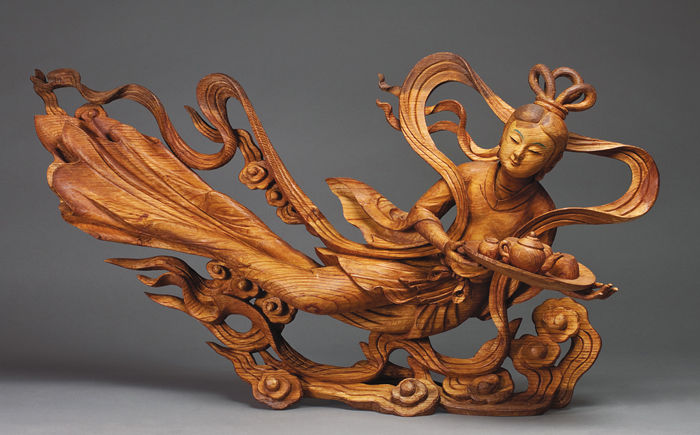
“A Bicheon Offering Tea” is carved by master Heo Kil-yang and portrays a bicheon, or Buddhist deva, offering pure tea to the Buddha and the bodhisattvas. (Photo courtesy of Heo Kil-yang)
The bicheon, also known as heavenly maidens or gandharvas, have been vividly revived and elaborately brought to life in his sculptures. According to Heo, the master was inspired mostly by the bicheon figures carved on the divine Bell of King Seongdeok, by the bicheon that can be found etched on the beams of the Daewoongjeon, the main hall at Sudeoksa Temple in Chungcheongnam-do (South Chungcheong Province), as well as by other Buddhist paintings and murals. He spiced them up with a bit of his imagination, too.
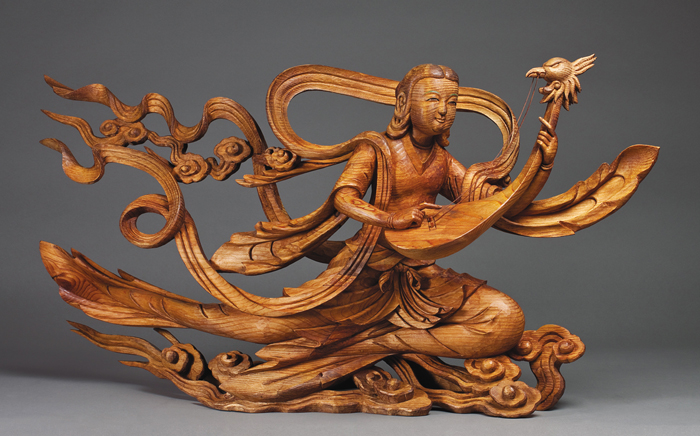
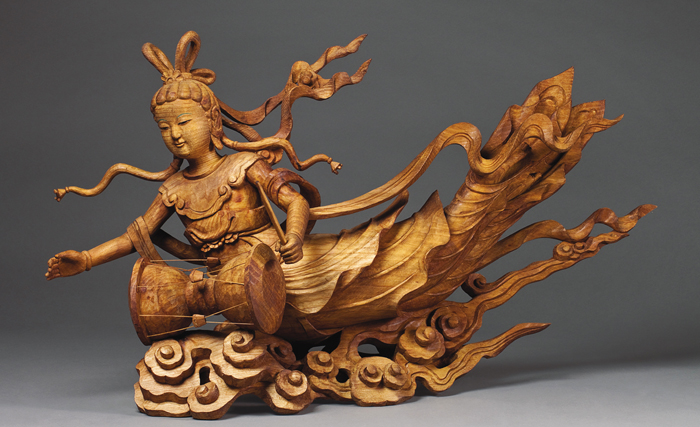
Artisan Heo Kil-yang’s “A Bicheon Playing a Lute with a Phoenix Head” (top) shows a bicheon, or celestial deva, slowly flying across the sky as she plays a lute. Another carving of his, “A Bicheon Playing a Drum” (bottom), is carved into the shape of a heavenly maiden with a heart-warming smile playing a drum. (Photos courtesy of Heo Kil-yang)
“First, I would carefully select a large section from the trunk of a pine tree that had a diameter of at least 80 centimeters,” said Heo. “I never use sandpaper and only use my chisels to make the surface smooth.”
As the master described it, he would go through a repeated process of carving and then rounding off. Created after such arduous manual effort, the 33 bicheon statues have now come to life, some chiseled as if the deva is gracefully flying down from heaven, offering food to her Buddha or playing a lute.
The deities’ wafer-thin clothes are adorned with a pattern of tree rings, while every single one of the thinnest of strings on the instruments is exquisitely carved out of bamboo.
The artisan started wood carving at the early age of 15 in 1968 and studied under renowned teachers in the world of Buddhist art. Since then, he has devoted more than 45 years of his life to carving wooden religious statues.
Korea.net met the master, who tries to keep the tradition of Buddhist art alive, to hear about his 45 years in the field.
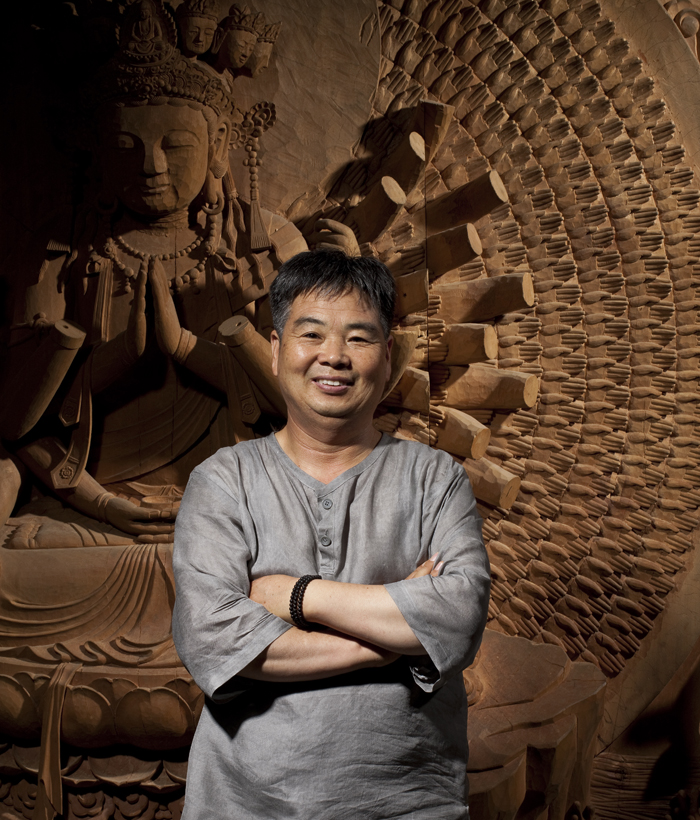
Woodcarving master Heo Kil-yang (Photo courtesy of Heo Kil-yang)
1. You have been in this woodcrafting field for more than 45 years. We’d like to hear more about what made you decide to have a career in wood carving.
I had a mother who was a deeply devout Buddhist. Before entering primary school, I studied for a year as a young monk at Seonamsa Temple in Jeollanam-do (South Jeolla Province). I used to always be around monks who were carving something. I enjoyed watching them whittle and work with their tools and materials.
I am not sure about whether or not that experience influenced me later. I just started thinking about creating something related to Buddha with my own hands, like those monks.
Luckily, I had the chance to learn the basic techniques from Seo Su-yeon and Lee In-ho, both of whom, at that time, were hailed as master woodcarvers. I found it quite interesting to see a piece of wood morphing into something completely different over time. To be honest, I worked day and night at it.
2. We can’t talk about you without mentioning Buddhism. Tell us about why you chose to delve deeper into this religious art form.
It was in 1977 when I first felt that my woodcarving had reached a degree of perfection. In that year, I won the Buddhist Art Competition of Korea. Even if a highly-skilled Buddhist artist doesn’t strictly follow Buddhist doctrine, at least some amount of profoundness is to be found in his pieces of art.
For that reason, I was so lucky to learn, per se, the “spirit of the art,” as well as the techniques from Monk Wooil who had shepherded the legacy of Buddhist art from the Joseon Dynasty (1392-1910) into modern times. All my time studying under the monks consolidated the foundation, helping me to get a deeper understanding of the art.
For this second exhibition, I used quite new composition and carving techniques to create the 33 bicheon statues. I modeled them only after existing paintings or Buddhist scriptures and then gave shape to them. It took three or four months to create one piece. I repeated the routine: carving, polishing and trimming. I never sandpapered them down and instead smoothed them using only my chisels. If I were to have sanded them, they would have gotten darker and would have easily lost their beautiful tree ring patterns when lacquered. I cleaned them immediately, right after I applied the lacquer, so the stain wasn’t able to soak into the wood.
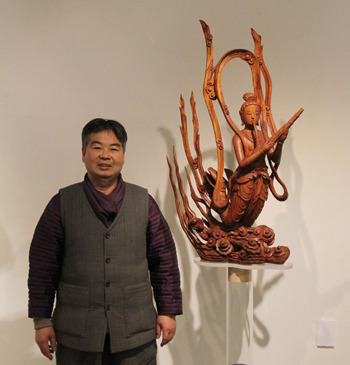
Artisan Heo Kil-yang stands next to his favorite, “A Bicheon Playing a Reed Aerophone,” just one amongst the 33 bicheon statues made of pine on exhibit at his ongoing “Pine Trees Become Bicheon” exhibition at the Seoul Arts Center. (Photo: Sohn JiAe)
Those who carve a Buddhist statue are often called the “Mother of Buddha.” A Buddhist statue is not only an object of devotion, but also a work of art. Those sculptors, like me, should put our devotion and true heart into our work. If our thoughts err from the right path, the statues we carve would not be sacred. What the face of a Buddha statue looks like depends on the “Mother of Buddha,” I mean, the one who carves it.
Many religious people bow to my Buddha sculptures. With them in mind, I should take on as devout a demeanor as they do. That’s why I have never touched even a drop of alcohol or a cigarette.
4. Could you tell us about what “carving” means to you?
In a nut shell, it means everything to me. Much of the art work created by our ancestors has now become national treasures. I always try to keep alive that spirit.
No less important is fostering the next generation of artists who will keep this legacy alive. However, these days, young people won’t carve because it is too difficult and time-consuming. Nonetheless, I have a sense of duty to spare no effort in training my disciples. All of these works are my whole life. I have been embedding my spirit into every single piece of art I make, and will continue to do so in the future.
5. We heard that you are planning to take your oeuvre outside Korea to other countries, including the U.S. and Britain. What are your future plans?
Many people have come to me and said that my work should be introduced to a more global audience. Yes, I hope to do so. Actually, I am planning to exhibit my collection in three regions, the U.S., Europe and Japan. In Europe, people there are used to seeing many pieces of art, usually made of stone. So when they see my wooden Buddhist statues, Europeans will find them quite interesting and unique, I guess.
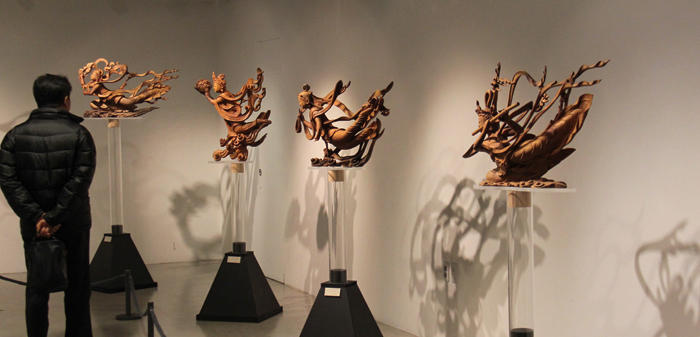
Master Heo Kil-yang’s “Pine Trees Become Bicheon” exhibition is underway at the Seoul Arts Center (SAC). (Photo: Sohn JiAe)
Heo Kil-yang’s “Pine Trees Become Bicheon” exhibition will continue until January 16 at the Seoul Arts Center (SAC).
By Sohn JiAe
Korea.net Staff Writer
jiae5853@korea.kr